Last updated on 5th October 2023 at 14:01 by Alex Nicholas
In the world of e-commerce, Shopify has become a household name that's growing quicker than any other eCommerce website builder due to it's ability as an all-in-one platform that allows businesses to quickly create an online store and sell to their audience without the need for expensive developers.
It's the ideal choice for all sizes of companies, whether you're a small business owner with minimal stock or larger enterprise companies with thousands of products and complex needs, Shopify has a solution to meet pretty much all of your demands and is the reason that I, as an eCommerce SEO consultant recommend it for the vast majority of eCommerce site builds.
Before you read the whole Shopify review, here's a quick breakdown of Shopify's main attributes:
- User-friendly: Shopify is known for its ease of use, and even beginners can quickly set up and manage their online stores with its user-friendly interface.
- Customizable: Shopify offers a range of customizable templates and themes that allow users to create unique and visually appealing storefronts.
- Secure: Shopify is a highly secure platform that employs multiple layers of security to protect its users' data and transactions.
- Mobile-ready: Shopify offers mobile-responsive templates that allow customers to shop on the go and for merchants to manage their store from their mobile devices.
- Payment gateway integration: Shopify has its own payment gateway, Shopify Payments, and it also integrates with over 100 third-party payment gateways, making it easy for customers to pay and merchants to receive payments.
- Inventory management: Shopify's inventory management system makes it easy to manage and track stock levels, set up notifications for low inventory, and more.
- Marketing and SEO tools: Shopify provides built-in marketing and SEO tools that allow merchants to promote their stores, run email campaigns, and optimize their sites for search engines.
- App store: Shopify's app store offers a wide range of apps and integrations that allow users to add new features and functionalities to their stores.
- Customer support: Shopify offers 24/7 customer support via phone, email, and live chat, ensuring that users always have access to help when they need it.
In this in-depth review, I'll take a closer look at Shopify and explore how it can benefit your business, and why I recommend it for 95% of online sellers, as well as using it on my own eComm projects.
Key takeaway
As I've just mentioned, Shopify is my go-to platform for eCommerce websites these days due to it's flexibility, performance, ever-improving app store and incredible themes. Not to mention the payment gateway and hosting sorted straight out of the box.
And by using Shopify you can essentially do away with developers to begin with because it's super easy to set up your own store in no time, leaving more money for marketing your products and dealing with orders, which is why I recommend it so often.
- How does Shopify work
- Shopify pricing
- Shopify point of sale
- Different Shopify payment gateways
- How is each Shopify plan different
- Is Shopify good for beginners
- The best Shopify themes
- Creating your Shopify store
- Shopify backend
- Shopify product variations
- Shopify images
- Collection pages
- Shipping
- Abandoned cart recovery
- Sales channels
- Editing Shopify's code
- Shopify analytics
- Is Shopify good for SEO
- Shopify app store
- Shopify mobile seller app
What is Shopify?
But first, it's important to understand that Shopify is an eCommerce platform that allows businesses to create and manage an online store so that they can sell directly to the public.
Shopify is a Canadian company founded in 2006 by Tobias “Tobi” Lütke and Scott Lake that was developed after they became frustrated by the lack of quality eCommerce platforms they had at their disposal for their snowboarding company, Snowdevil, and since then it's grown to become one of the most popular eCommerce platforms in the world, giving businesses the ability to sell products online, manage their inventory, process payments, and more, with great features and flexibility.
One of the main advantages of using Shopify is that as you've probably gathered already, it is an all-in-one platform. This means that businesses don't need to use multiple tools to manage their online store. Shopify provides everything from website creation to built-in analytics.
Shopify also has an incredibly intuitive and user-friendly interface. The platform comes with a range of templates/themes to choose from, many of which are fully customizable. This means that even businesses with little to no coding experience can create a professional-looking website in no time.
Another big advantage of using Shopify is its app store (which I'll come on to later). The app store offers a wide range of third-party apps that can be used to enhance the functionality and performance of your online store. For example, businesses can use apps to add social media sharing, customer reviews, compress image sizes and have live chat on their store.
Overall, Shopify is a powerful eCommerce platform that can benefit businesses of all sizes. It provides everything businesses need to manage their online store in one place, and it is easy to use even for those with little to no technical experience.
How does Shopify work?
Shopify is a hosted eCommerce platform (meaning you don't need to sort out the hosting for your website on top of everything else), which means that businesses don't need to worry about setting up and managing their own web hosting. When a business signs up for Shopify, they are essentially renting space on Shopify's servers to host their website and manage their online store.
Once a business has signed up for Shopify, they can choose from a range of themes to create a website for their store. These Shopify templates are fully customizable, which means that businesses can tailor the design to match their brand.
As a Shopify user myself, I recommend using Out of the Sandbox which makes great themes. Their themes are a one-time purchase and very well supported, unlike many others, especially free themes.
After creating a website, businesses can easily add products to their store and manage their inventory at a glance, making it easy to track inventory levels and receive notifications when products are running low.
And most importantly, businesses can also use Shopify to manage customer orders and process payments.
Shopify also provides a range of payment options for businesses to choose from, including credit card payments, PayPal, Shop Pay and Apple Pay. Shopify also has its own payment gateway, which makes it easy for businesses to process payments directly through their online store.
How many sites are built with Shopify?
Shopify has become a popular choice for businesses of all sizes and types. As of 2021, there were over 1.7 million websites built with Shopify. These websites range from small businesses to large enterprise companies and include popular household names such as PepsiCo, Heinz, and Gymshark.
And the fact that big brands are using Shopify shows that you should seriously consider using it, too, because it provides everything a business needs to create and manage a professional online store.
Shopify pricing – how much does cost?
One of the benefits of using Shopify is its flexibility in terms of pricing. Shopify offers different plans to suit the needs of businesses of all sizes, and businesses can upgrade or downgrade their plan at any time. This means that businesses have control over their monthly cost and can adjust it based on their current needs.
Shopify offers four different pricing plans:
- Basic Shopify – £19 per month
- Shopify – £29 per month
- Advanced Shopify – £249 per month
- Shopify Plus – from $2000 per month
The Basic Shopify plan includes features such as a website, two staff accounts, and basic inventory management. Transaction rates are 2% + 25p for online transactions and 1.7% + 0p for in-person transactions.
The Shopify plan includes additional features such as gift cards, professional reports, and up to five staff accounts. Transaction rates are 1.7% + 25p for online transactions and 1.6% + 0p for in-person transactions.
The Advanced Shopify plan includes features such as advanced report building, up to 15 staff accounts, and third-party calculated shipping rates. Transaction rates are 1.5% + 25p for online transactions and 1.5% + 0p for in-person transactions.
Finally, the Shopify Plus plan is a custom enterprise solution that is tailored to the needs of large businesses and has a degree of development costs involved.
In addition to the monthly cost, Shopify also offers an annual billing option. Businesses that opt for annual billing can save up to 10% on their monthly cost. This can be a good option for businesses that have a stable cash flow and are looking to save on their overall cost.
One of the main factors to consider when it comes to which Shopify pricing bracket you'll fall under is the number of staff accounts needed and transaction volumes.
Staff accounts allow businesses to give their employees access to the Shopify platform and manage specific areas of the business. Businesses can add additional staff accounts to their plan for an additional monthly cost, which is key when you're bringing staff to fulfil specific roles within your company.
But most importantly, if your store starts to do large volumes of sales then you should consider choosing the more expensive plans because by doing this you're not only unlocking more features that you don't get on the basic plan, you'll be saving in transaction fees.
So what you pay out for the more advanced plan you'll save in transaction fees – and of course, you can upgrade or downgrade your account at any point.
Shopify POS for brick & mortar businesses
In addition to its online platform, Shopify also offers a point of sale (POS) system that allows businesses to sell products in person and is a great option for businesses that participate in trade shows, have a pop-up store, or have a physical retail location.
The Shopify POS system is easy to use and includes features such as a card reader, barcode scanner, and cash register. Businesses can use the POS system to process payments, manage inventory, and track sales data in real time.
It also connects to the business's Shopify store, which means that inventory levels and sales data are synced across both the online and in-person channels.
The POS system is available as an app that can be downloaded on a tablet or mobile device. This makes it easy for businesses to take their POS system with them wherever they go. The app also includes a range of customization options, which means that businesses can tailor the app to match their brand.
All of this makes it a great option for brick-and-mortar businesses that are looking to expand their online presence and sync all payments and stock levels.
Different payment gateways you can use on Shopify
Another great benefit of using Shopify is the variety of payment gateways that businesses can use to process payments.
This is important because customers often have a preferred payment method for online transactions, which in turn will increase conversion rates.
Here are some of the most popular additional payment gateways that can be used on Shopify:
- PayPal: PayPal is a popular payment gateway that allows businesses to process payments from customers all over the world. With PayPal, customers can pay using their PayPal account or with a credit card. PayPal also provides a range of fraud prevention tools to help protect businesses from fraudulent transactions.
- Shop Pay: Shop Pay is a payment gateway that is exclusive to Shopify. It allows customers to save their payment information securely and make purchases quickly and easily. Shop Pay also provides businesses with fraud prevention tools and chargeback protection.
- Klarna: Klarna is a payment gateway that allows businesses to offer customers the option to pay over time. With Klarna, customers can pay in instalments or defer payment for up to 30 days. Klarna also provides businesses with fraud prevention tools and chargeback protection.
- Credit Cards: Shopify also supports all major credit cards, including Mastercard, Visa and American Express.
- Apple Pay: Apple Pay is a payment gateway that allows customers to pay using their Apple devices. With Apple Pay, customers can make payments using their Apple Watch, iPhone, or iPad. Apple Pay also provides businesses with fraud prevention tools and chargeback protection.

Basically, Shopify provides a range of payment gateways that businesses can use to process payments that best suits their needs and the needs of their customers.
How is each Shopify plan different?
Shopify offers a range of pricing plans to suit the needs of businesses of all sizes. Each plan offers different features and pricing, which means that businesses can choose the plan that best suits their needs. Here's a breakdown of the different Shopify plans:
- Basic: The Basic plan includes features such as a website, unlimited products, up to 1000 inventory locations and basic inventory management. This plan also includes two staff accounts, which means that businesses can give employees access to the Shopify platform.
- Shopify: The Shopify plan includes features such as gift cards, professional reports, up to 1000 inventory locations and up to 5 staff accounts. This plan is a good option for businesses that need more advanced features and want to manage their online store more efficiently.
- Advanced: The Advanced plan includes features such as gift cards, professional reports, up to 1000 inventory locations and up to 15 staff accounts. This plan is a good option for businesses that need more advanced features and want to manage their online store more efficiently.
- Shopify Plus: The Shopify Plus plan is a custom enterprise solution that is tailored to the needs of large businesses. This plan includes features such as advanced report building and third-party calculated shipping rates. This plan is a good option for businesses that have a high volume of sales and need a more robust eCommerce platform. For example, Shopify Plus can comfortably handle up to 8000 orders per minute.
Each Shopify plan offers different levels of flexibility and control, which means that businesses can choose the plan that best suits their needs. The Starter and Basic plans are good options for small businesses just starting out, while the Advanced and Shopify Plus plans are better suited for larger businesses with more complex needs.
In addition to different pricing plans, Shopify also allows businesses to adjust their plan based on their current needs. This means that businesses can upgrade or downgrade their plan at any time, which provides them with more control over their monthly costs.
Is Shopify good for beginners?
Shopify is a great option for beginners who are looking to get into eCommerce and start an online store because the platform is designed with ease of use in mind, which means that even those with little to no technical experience can create a professional-looking website.
One of the benefits of using Shopify for beginners is the free trial period. Shopify offers a 14-day free trial or a trial period with a £1 fee, which means that businesses can try out the platform and see if it meets their needs before committing to a plan. This allows beginners to test the waters and get a feel for how the platform works.
In comparison to other development-heavy eCommerce platforms such as Magento (a solution I've had a lot of previous experience with), Shopify is a more beginner-friendly platform. Magento on the other hand requires more technical expertise and can be more challenging for beginners to use, even if it is slightly more customisable.
This is one reason why Shopify has become a popular choice for store owners who are just starting out, especially as this means you're left with more budget for the most important aspects of running an eComm site such as marketing.
The best Shopify themes to consider
Choosing the right theme for your Shopify store can have a big impact on the success of your business. A well-designed theme can improve the user experience, make your products look more attractive, and increase conversions. Here's my take on choosing the right Shopify theme:
- Fast: You need to get a fast theme, and although it doesn't have to be the fastest theme on the market (which can be highly subjective anyway), it needs to be fast enough that people don't get frustrated and leave because fast themes combined with a good UX convert much better. Therefore, I recommend using a premium Shopify theme that will have been tested endlessly.
- Flexibility: Your Shopify theme needs to be flexible so that you can give it the feel you need and has a look that allows your brand to speak to the customer. It's also critical for it to have a great user experience so that users can quickly navigate through your site. UX is also a ranking factor so you must get this right.
- Paid Themes: Shopify offers a wide range of paid themes that businesses can use to customize the look and feel of their online store. Paid themes are a good choice for businesses that want a theme that is specifically designed for their industry or business type, such as fashion, electronics etc. Paid themes have a wider range of features and functionality, which can help businesses stand out from the competition.
- Free Themes: Shopify also provides a range of free themes, and although these themes can be a good starting point for businesses that are just getting started that don't have a big budget, they don't have all the features of a premium theme and generally don't convert customers particularly well.
- Out of the Sandbox: I've left Out of the Sandbox until last because they're my personal favourite when it comes to themes. They're a popular provider of premium Shopify themes and are known for their quality and attention to detail. The themes are designed to provide a great user experience and increase conversions. Therefore, in my opinion, Out of the Sandbox themes are the choice for businesses that want a high-quality theme that is easy to use and customize.
When choosing the best Shopify theme, it's important to consider the design, features, and functionality that are important to your business. Look for a theme that is easy to use, provides a good user experience, and is tailored to your industry. With a wide range of free and paid themes to choose from, you're sure to find a Shopify theme that meets your needs and makes your online store stand out.
Shopify reviews for small business
Oftentimes times small businesses have limited budgets and don't have particularly complex needs when it comes to what they need from a website.
This is why Shopify is such a popular eCommerce platform and is used by businesses of all sizes, including small businesses, who can benefit from the features and functionality that Shopify provides without having the hassle of things like security updates and expensive hosting.
Overall, small eCommerce business owners have positive reviews of using Shopify. The platform provides the necessary features to get started with selling online without breaking the bank.
Creating your Shopify store is easy
Creating an online store can be a daunting task, but Shopify makes it easy to get going, quickly. And as already mentioned one of the standout features of Shopify is its user-friendly interface, which allows businesses to easily create and manage their store without needing to have any technical expertise.
The first step in creating a store on Shopify is to choose a plan that best suits your business needs, just make sure that you consider all of your needs before making a choice.
Once you've chosen a plan, the next step is to choose a design for your store. Shopify offers a wide range of customizable templates that can be easily adapted to suit your store's unique branding and style. The platform also allows users to create custom pages and sections to further personalize the look and feel of their site.
After you've chosen a design, you can start adding products to your store. Shopify makes it easy to add, edit, and manage products, with features such as product variants, inventory tracking, and product reviews. It's all very intuitive and easy to understand. Just take your time to get the feel of the platform and how it works.
There are also some basic store details you'll need to fill out which Shopify make you fill in, such as:
Store details such as email and phone number.
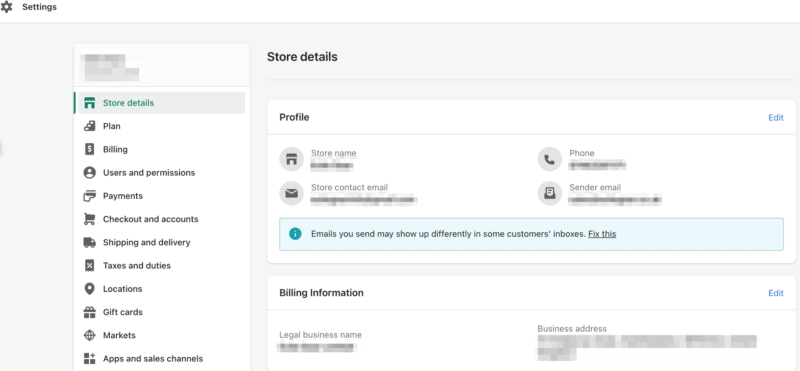
Billing, where you set up payment methods to and from Shopify.
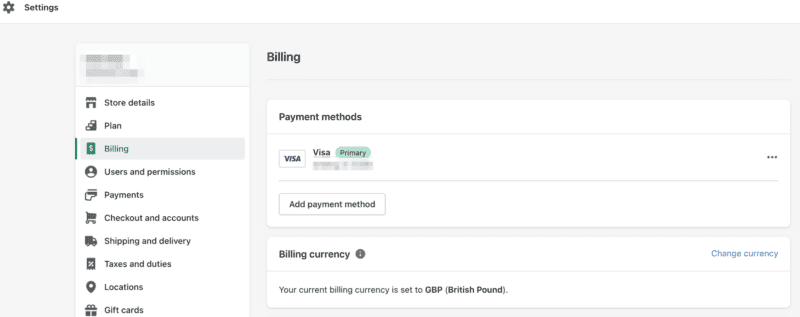
Payment providers that you want to integrate into your store that people can use to pay you.

Shipping rules on orders for domestic, overseas, price by weight etc. I cover this in more detail further down this article.
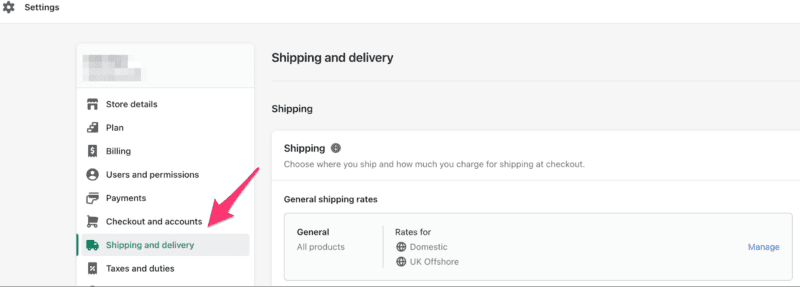
After you've sorted out the basics of choosing the plan you want, choosing your theme and filling in your store details, you then need to start uploading your products and content and make sure all shipping rules are in place.
Shopify's backend interface & ease of use
One of the benefits of using Shopify as an eCommerce platform is the ease of use of its backend interface. The backend interface is designed to be user-friendly, which means that businesses can manage their online store without the need for extensive technical expertise or know-how.
Below is a screenshot of what your dashboard will look like that has all of the key features you'll be using on a daily or weekly basis.
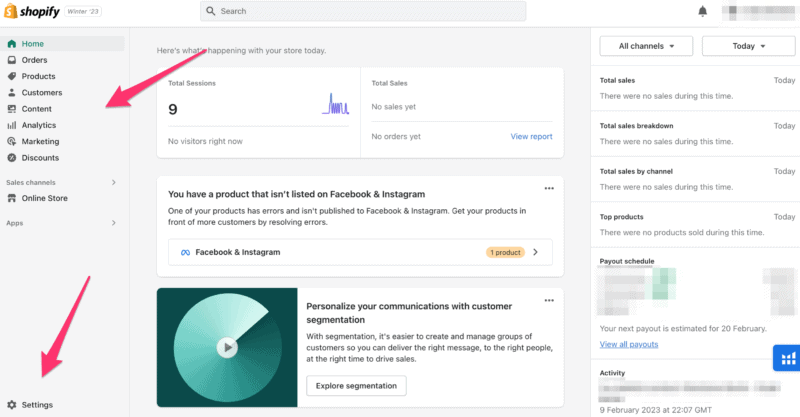
As you can see, everything you need is accessible from here, including the settings page where you have access to a large range of additional features.
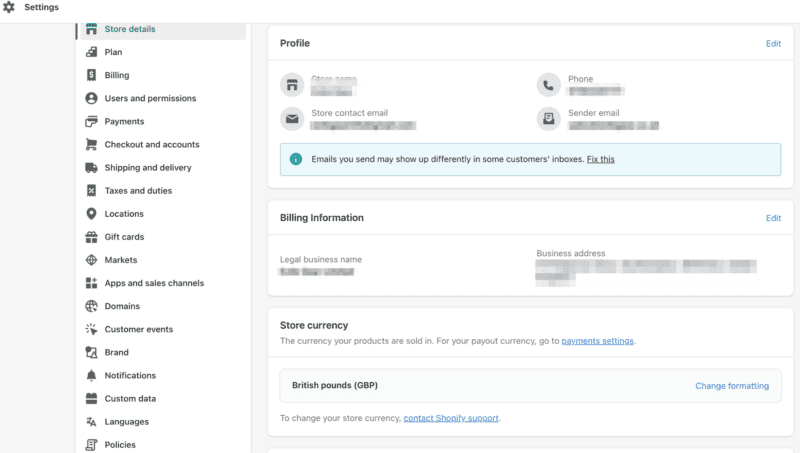
The Shopify backend provides businesses with a high level of flexibility and control. Site owners can create staff accounts with varying levels of access, which means that employees can be given access to the Shopify platform to manage specific aspects of the business. This allows businesses to delegate tasks and manage their online store more efficiently.
Uploading products and images to a Shopify site is also a simple process. Businesses can upload products one at a time or in bulk using a CSV file. This makes it easy for businesses to manage their inventory and keep their online store up to date.
To upload a product follow these steps:
Click on the products tab

To upload a product click on the green products on the right

Fill in the product description and add images

Overall it's a really simple product management system that allows you to easily add products and create collections in the way that you need to.
Managing products is an important aspect of running an e-commerce store and Shopify provides a range of features to help businesses keep track of their products.
Shopify also allows store owners to track inventory and manage product variants. This feature allows businesses to keep track of their stock levels and ensure that their products are always in stock. Additionally, Shopify allows store owners to set up automatic notifications for when inventory is low, so they can restock items before they sell out.
One thing you might not have thought of though is Shopify's ability to manage digital products. Shopify isn't just about selling physical products as store owners can also sell and distribute digital products such as e-books, music, and software.
The easy-to-use interface allows store owners to filter products by category, tag, or collection. This allows store owners to group products together and make it easy for customers to find the products they are looking for.
Shopify product variations
One of the main features for a lot of eCommerce sites is product variations, so Shopify gives site owners the ability to create product variations so they can offer a range of options for their products. Here's how product variations work in Shopify:
- Product Page: On the product page, businesses can display the different variations of the product. This can include variations such as size, colour, or material. Each variation can have its own price, SKU, and inventory count. You can also create more than one variation if you need to.
- Collections: Businesses can also create collections of products that are related to each other. This can help customers to find products that match their interests or needs.
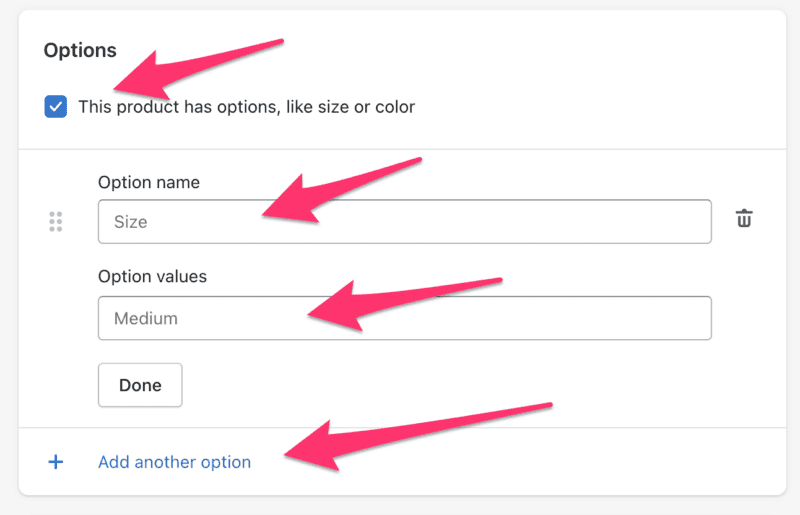
Overall, product variations are an important feature of Shopify that allows businesses to offer a range of options for their products. By creating different variations of a product, businesses can offer more choices to their customers and increase the likelihood of a sale.
Product images
Images are an essential element of any eCommerce store and are the first thing a customer will see.
Product images help customers to visualize the products they are considering and can play a significant role in their decision-making process.
To upload a product image in Shopify simply go down to the media section on the product page and click on “add” in the media section, then locate your images from your computer.
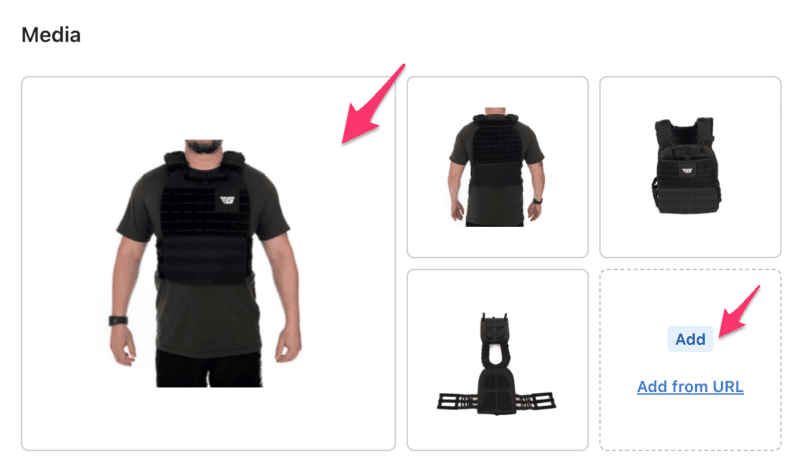
Although Shopify uses a content delivery network (CDN) to improve performance, it's a good idea to instal an app from the app store that compresses your images so they don't slow your site down.
It's also a good idea to use WebP file format for your image as well as add alt text to your images. This essentially is telling search engines and site readers what your image is. And by doing this your images will also show up in Google images and potentially Google Lens.
But above all good images will improve the customer experience and increase sales.
Content creation for your Shopify store
Creating content is an important part of any eCommerce business. By creating content, businesses can establish topical authority, connect with bloggers and influencers, and drive traffic to their online shop. In addition, content can play a critical role in search engine optimization (SEO) and improve the ranking of collection pages and blog posts. Here's how Shopify supports content creation in addition to what's within the product pages:
- Blog: Shopify provides businesses with a built-in blog, which allows them to create and publish content easily, and interlinked to products and collection pages.
- Collection Pages: Collection pages are a key part of any eCommerce store and are easy to rank within Google. These pages display a range of related products, can have content either above or below the product pages and can be optimized for SEO.
- Pages: In addition to blog posts you can create standard pages that can sit within key areas of your site, bring in traffic and link through to anywhere else on your site
Shopify collection pages
Shopify collection pages are arguably the most important element of any Shopify eCommerce store and huge revenue sources as these pages display a range of related products and can be optimized to improve the user experience and drive sales.
They're also preferred by Google as generally speaking they provide the best user experience in the sense that when a searcher lands on a collection page they can immediately see a range of related products that might suit their needs.
However, you need to be very careful not to simply add a random range of products together within a collection page. A collection page needs to have products within it that are very closely related.
And if you have a massive range of products that have a number of variations it's a good idea to add some appropriate filtering such as colour, size etc.
Flexible shipping options
Shipping is an important element of any eCommerce store. With Shopify, businesses can easily manage their shipping options, ensuring that they can provide reliable shipping to customers worldwide. Here's how shipping options work in Shopify:
- Head over to settings in the dashboard
- Find “Shipping and delivery”
- Set your rates based on location, free over a certain spend, weight or completely free because you're feeling kind.
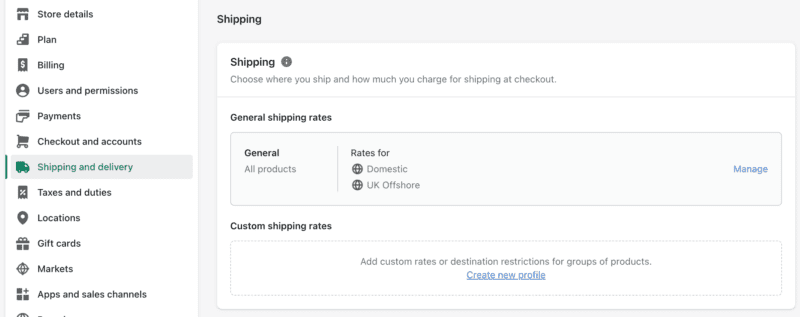
Overall, shipping options are an important part of any eCommerce store and with Shopify, businesses can easily manage their shipping options, providing reliable shipping to customers around the world. By setting rules for shipping based on the size and weight of products, businesses can provide accurate shipping rates to customers, improving the customer experience and increasing the likelihood of a sale.
Another great benefit of using Shopify as an eCommerce platform is the wide range of apps and plugins that 3rd party carriers use to integrate with the platform. This includes a variety of couriers that can be used to manage shipping and provide the best rates to you, which you can then utilise with your customers.
And we're not talking about small-time couriers either as major couriers like FedEx, UPS, DHL and DPD (who I personally use) all allow their services to be used.
Abandoned cart recovery
One of the challenges of running an eCommerce store is dealing with abandoned carts. Abandoned carts occur when a customer adds items to their shopping cart but then leaves the store before completing the purchase. Shopify provides businesses with a range of tools for recovering abandoned carts and increasing sales.
And trust me, a good percentage actually return to buy through the abandoned cart message so it's something you need to utilise.
Sales channels you can use with Shopify
An omnichannel approach to eCommerce has become increasingly important for businesses in recent years, and Shopify really excels here.
Shopify offers a range of sales channels that allow businesses to sell their products across multiple channels, improving the reach and profitability of the business. Here's how multi-sales channels work in Shopify:
- Your store: Obviously the primary sales channel for businesses on Shopify is their online store so I won't dwell on this one.
- Social media: Shopify also integrates with Facebook/Meta and Instagram, allowing businesses to sell products directly through each social media platform. This can be a powerful marketing tool, as businesses can showcase their products to a large and engaged audience and sell to them at the same time.
- Other store Owners: In addition to the online store and social, Shopify Plus store owners can allow both wholesale sales channels and have a dropshipping capability. Meaning other retailers can sell your products in their stores and your stock updates accordingly.
Overall, sales channels are an important part of managing an eCommerce store, and with Shopify, businesses can easily sell their products across multiple channels, improving their reach and profitability.
Multiple currencies
Online shopping has made it possible for businesses to sell their products to customers all over the world so it's important to give potential customers the ability to get an understanding of what a product costs in their own currency.
Ideally, your theme will handle this for you, like Turbo from Out of the Sandbox. But if it doesn't then Shopify offers a range of apps for managing multiple currencies, allowing businesses to sell their products in different countries and currencies.
Gaining reviews and adding to products in Shopify
Reviews are an important part of the e-commerce experience, and Shopify understands this and has enabled all of the major review companies to build apps that integrate seamlessly with Shopify.
Reviews on products are incredibly powerful when it comes to converting customers (hello Amazon), as they give other potential customers insight into the quality and value of the product. This also helps to build trust and credibility for the store and its products.
Shopify also makes it easy for store owners to manage and respond to reviews. Store owners can quickly and easily view all reviews, respond to any questions or concerns, and even flag any inappropriate or fake reviews. This helps to ensure that the reviews on a Shopify store are genuine and trustworthy, which can help to boost customer confidence and increase sales.
Add Schema so that review stars show in the SERPs
Following on from reviews, it's also very important that you add Schema markup in the form of structured data to your site so that you provide search engines with additional information about a website in the form of machine-readable content, and most importantly, your reviews!
By utilizing Schema markup you're greatly improving the visibility of your products in search engine results pages (SERPs) and will increase the click-through rate from the SERPs to your site.
Editing the code of your Shopify store
Shopify provides businesses with a powerful eCommerce platform that is easy to use and requires little technical knowledge to set up and run. However, for businesses that require more advanced customization options, Shopify also provides the ability to edit the code of a Shopify store.
Shopify's code is built on Ruby on Rails, which is a popular web development framework. This code forms the foundation of the Shopify platform and provides a range of customization options for businesses.
To edit the code of a Shopify store, businesses can access the theme files for their store. These files contain the code that defines the layout, functionality, and design of the store. Businesses can modify these files to create custom themes that reflect the unique branding and requirements of their business.
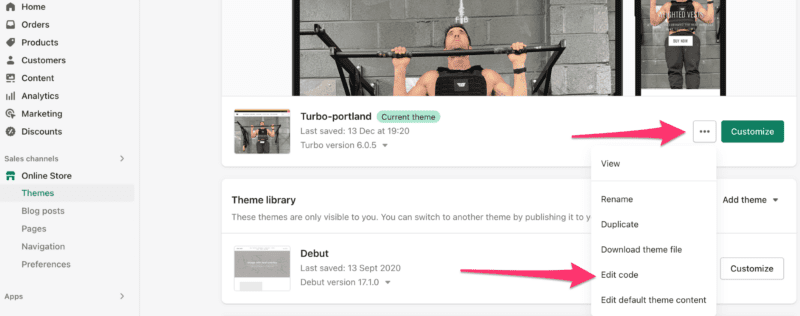
From here you'll find all of the code for your store.

Editing the code of a Shopify store requires some technical knowledge and experience with web development so be a little careful when making changes. Either that or work with a dev that's familiar with Shopify.
Shopify analytics
Shopify provides store owners with a range of tools that allow them to quickly and easily look at a number of reports that tell them where their traffic is coming from, what the store's conversion rate is and most importantly where their best sources of traffic are coming from.
From your dashboard click on the Analytics tab to open up the report, where you can change the date range to see what your sales totals are for whatever period you need to see.
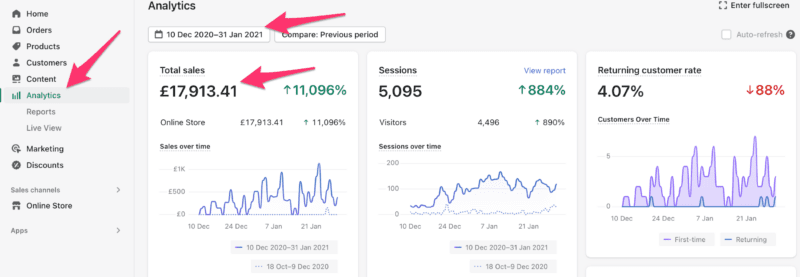
You can also see what your conversion rate is, how many people added to cart, how many reached the checkout stage and how many actually converted, along with your average order value.
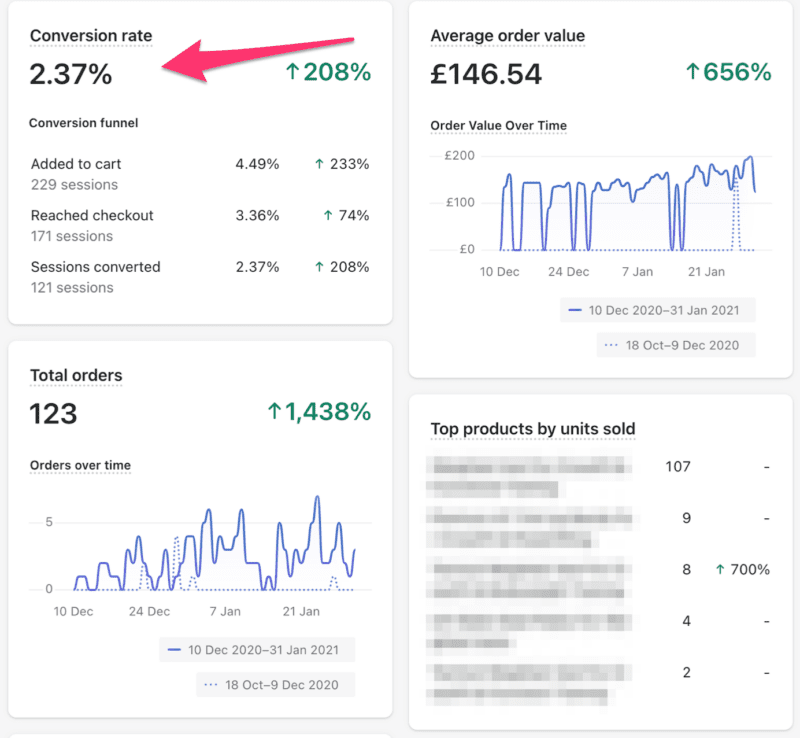
You also get to see whether they were mobile, desktop or tablet users, the traffic source and which pages were your top landing pages (the page people clicked on to your site).

You should also install your Google Analytics tracking code into your store to get a fuller picture of where your visitors are coming from, how they're behaving and what they're doing on your site.

To install your Google Analytics:
- Copy your GA code from your Google Analytics account
- Go to your Shopify dashboard
- Click on Online Store
- Preferences
- Scroll down to Google Analytics
- Paste your GA code
Overall, Shopify's marketing reports provide you with a decent overview of what's going on with your site and what your most profitable channels are. But they are just a bird's eye view as to what's happening and you shouldn't base too many marketing decisions around it.
For fuller data, you need to analyse Google Analytics to see things like customer journey and dropoff points.
The security of your Shopify store
Security is a critical consideration for any eCommerce store, especially as eComm stores are YMYL (your money or your life) which means you're handling things like payments. The good thing is that Shopify handles this for you which in itself removes a huge headache.
And to give you a little more insight into website hacking, roughly 13'000 WordPress sites (including WooCommerce) get hacked daily…
Now don't get me wrong, some of this is due to the sheer volume of WordPress/WooCommerce sites there are on the internet, but a lot of this is due to the fact it's open source and simply not as secure as it could be.
And at the end of the day, everything could be going in the right direction with your eCommerce venture, but if it gets hacked then all of your hard work could be in vain and you're effectively a sitting duck.
So to combat hackers, keep your site safe and most importantly keep your customer's details safe, Shopify deploys an up-to-date SSL certificate, which encrypts data sent between the user's browser and the website to protect sensitive information, such as credit card numbers, from interception.
Shopify also employs a content delivery network (CDN), which helps to improve the performance and security of the website. The CDN distributes content across multiple servers, reducing the load on any one server and improving the speed of the website.
This is because one way of breaking into a site is to flood it with traffic until the site effectively “falls over”, which can create a vulnerability that hackers can exploit.
They also carry out regular testing for vulnerabilities, monitoring for suspicious activity, and deploy strict access controls.
Shopify alternatives
While Shopify is a popular and powerful eCommerce platform, there are a range of alternatives available for businesses looking for other options. Here are the top three most popular Shopify alternatives:
- Magento: Magento is a powerful eCommerce platform that is open source and highly customizable. While it requires more technical knowledge to set up (or a developer) and run than Shopify, it does offer a wide range of features and is both flexible and highly scalable.
- WooCommerce: WooCommerce is a popular eCommerce plugin for WordPress. It is easy to set up and use, making it a good option for businesses that already have a WordPress website. But as I mentioned in the security section, it does come with vulnerabilities and you should expect to be targeted daily by hackers. Especially as your site gets more traffic and becomes established.
- BigCommerce: BigCommerce is a cloud-based eCommerce platform that is highly scalable and offers a range of features, including built-in marketing and analytics tools.
Overall, there are a number of options available for businesses looking for eCommerce platforms beyond Shopify. From highly customizable options like Magento and website development to more user-friendly options like WooCommerce and BigCommerce. It all comes down to your needs, ability to hire the right developer in the case of Magento and budget.
Army of Shopify developers
Although Shopify is a powerful eCommerce platform that provides businesses with most of what they want straight out of the box, there are times when you might need a developer to customise something for you.
Luckily there are a large number of developers out there that have plenty of experience when it comes to developing and customising Shopify stores and the Ruby on Rails web development framework.
And if you don't already have a developer in mind you can look through Shopify's expert section to find a dev that could help you.
Shopify customer support
Like all good SaaS (software as a service) providers, Shopify offers robust customer support, with a dedicated team available to help with any issues that may arise. They offer 24/7 customer support, which is available through phone, email, and live chat. Additionally, the Shopify community forum is a great resource for finding answers to common questions and troubleshooting issues.
Is Shopify good for SEO
I often hear or get asked about how Shopify performs when it comes to SEO (search engine optimisation), and in all honesty, it's no different to any other platform because SEO is so much more than the platform you're using.
SEO is about matching user intent with the right content, user experience, a well-built and fast site, and backlinks. If you get these three things right and have patience then you'll win, and win big!
But I want to spend a little time on backlinks because they often get a bad rap these days from people who have drunk the Google cool-aid and believe they are either not needed or dangerous, and this is so far from the truth because links are the fuel that will power your site in the SERPs, especially within competitive niches.
To give you an idea of what I mean let's look at the screenshot below from Ahrefs for the search term – resistance band exercises.
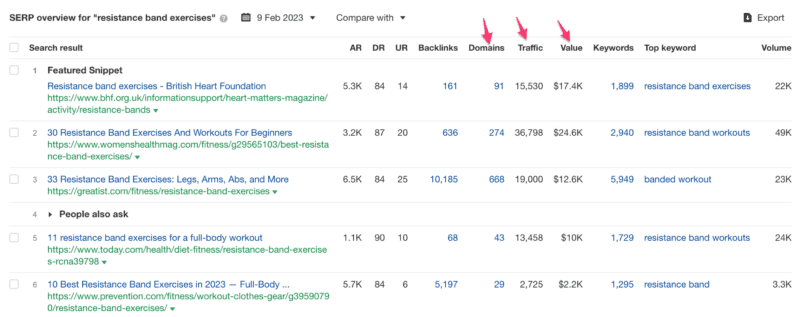
What we can see here are 3 things:
- This is a competitive search and there's a lot of traffic to be had from this one search term
- The traffic value (how much it would cost to get this traffic if you were doing PPC) is super expensive
- You 100% need backlinks to rank. As you can see from the domains section the top sites have all gone on a linkbuilding campaign.
You simply cannot rank in spaces where there's good money to be made without links.
I created a Shopify store SEO checklist if you need more information on optimising your store.
The Shopify app store
I'm sure you don't need me to tell you that apps are a big deal these days and that there are apps for pretty much everything, and Shopify is no different.
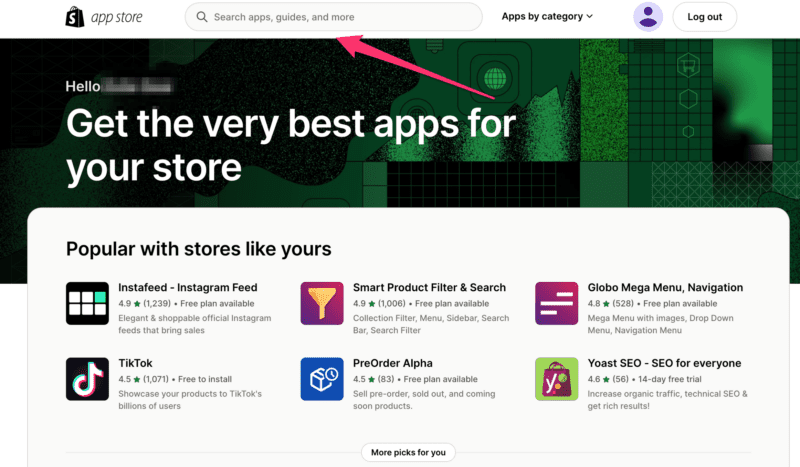
The Shopify App Store is a great marketplace for apps that can be used to optimize and improve the functionality of Shopify eCommerce stores. Here's how the Shopify App Store works:
- From your dashboard click on the apps tab
- From here you'll be directed to the app store
- Search through the App store for pretty much anything you need
Overall, the Shopify App Store is a valuable resource for businesses looking to optimize and improve their eCommerce store, just be careful not to go too overboard and ad apps for everything because they will slow your site down.
Make sure that you only select apps that best fit their needs and budget.
Shopify and email marketing
Email marketing is a really important part of eCommerce marketing, and Shopify makes email capturing and marketing easy with a range of email apps that are proven to increase customer retention and repeat sales.
Nearly all apps integrate seamlessly, but without a doubt the number one email marketing app is Klavio. Klaviyo provides businesses with a range of tools for creating targeted email campaigns, including segmentation and automation features. With Klaviyo, businesses can create highly personalized and effective email marketing campaigns that work better than the others.
Now don't get me wrong, you get out what you put in but Klavio seems to have nailed down the workflow process better that the rest and helps you build strong customer relationships.
But the main reason that eComm site owners should never overlook email marketing is that it's so much easier to keep a customer than it is to acquire a new one.
Dropshipping with Shopify
You might have heard of the term dropshipping and are wondering what it is and whether or not it's a viable business model for you.
Dropshipping has been a popular business model for a while now because it involves selling other people's products online without holding inventory, meaning you can be up and running quickly and have more money to spend on marketing and SEO.
If you do go down this route Shopify makes the process easy due to the large number of tried and tested apps available that allow you to integrate with other sites and outlets.

There are two ways you can go about dropshipping:
#1 – By getting in touch with and agreeing to sell products from other sellers from within your niche.
This is something I've personally done in the past and would be my preferred route if I were to set up a dropshipping website ever again. This is because when you agree on terms and conditions with sellers within your niche you will have very structured prices, shipping fees and shipping timescales that you can apply to your own store.
#2 – By listing products from places like the Far East.
Although this approach is potentially more profitable, it also comes with much bigger headaches.
This is because you're buying products from factories that are many miles away and will have really long shipping times with no guarantee that the products will even turn up!
There's also the problem of having to go through middlemen rather than the factories that make the products because you're only ordering small numbers at a time which will also add time to an already long delivery time. All of which will lead to an irritated customer and a ton of refunds.
Tax rules on Shopify
Managing taxes and VAT (Value Added Tax) is an important consideration for eCommerce businesses, especially those making overseas sales. Shopify provides allows you to apply tax rates automatically for a large number of territories, which is a big time saver.
Not only that but registration-based taxes (which cater for VAT/state-based taxes etc.) are available for:
- Australia
- Canada
- European Union
- New Zealand
- Norway
- Switzerland
- United Kingdom
- United States
VAT MOSS on Shopify
The EUs VAT MOSS (VAT Mini One Stop Shop) rules are something that Shopify handles really well for you on your behalf.
VAT MOSS is a requirement from the EU for sellers of digital products to consumers in the EU to add VAT to each product on a country-by-country basis, there’s a VAT rate to be applied for Italy, one for Spain, one for Ireland etc.
Shopify calculates and applies the appropriate digital tax rate automatically. So there’s no need for you to worry about setting up manual tax rules for each country.
Using the Shopify seller app on your phone
The Shopify Seller App is a mobile app that enables Shopify store owners to manage their online sales on the go. The app provides a limited but helpful range of functionality, from managing products and inventory to tracking sales and processing payments.
However, one of the standout features of the Shopify Seller App is the cha-ching sound that plays every time a sale is made. This is something that I personally love, even at 3 o'clock in the morning!

It adds an extra level of satisfaction and motivation for business owners, especially when starting out and provides a fun and engaging user experience.
Shopify and GDPR Compliance
The General Data Protection Regulation (GDPR) is a set of regulations designed to protect the privacy and data of individuals in the European Union (EU). The GDPR applies to businesses that process the personal data of individuals in the EU, regardless of the location of the business. This means that businesses in the UK, USA, and other countries must comply with the GDPR when collecting and processing personal data.
Shopify provides a range of apps to help businesses comply with GDPR regulations because this isn't something Shopify deals with out of the box.
These app features include things like data export and deletion, consent management, and cookie banner customization. In addition, Shopify has published a detailed GDPR compliance guide for businesses using the platform.
To comply with GDPR regulations, businesses using Shopify should ensure that they are collecting only the data that is necessary for their operations, obtaining explicit consent from users before collecting their personal data, and providing clear and detailed privacy policies to users.
Businesses should also ensure that they have processes in place for responding to user requests for access to their personal data, data deletion, and data correction. These processes should be documented and communicated clearly to customers.
Please note though, that I am an eCommerce SEO consultant and not a lawyer, so if you're in any doubt please take legal advice.
Final thoughts on using Shopify for your eComm platform
As I mentioned at the beginning of this massive article, I'm a Shopify advocate and user and will recommend it for the vast majority of eCommerce ventures for these simple reasons – it's affordable, scaleable, flexible and SEO friendly.
Does it have it's limitations? Of course it does, but unless you're willing to spend big money on a bespoke platform build then every eComm platform will have it's drawbacks.
Shopify does everything you need well and will allow you to focus on the important aspects of running your store, such as marketing and fulfilling orders.
